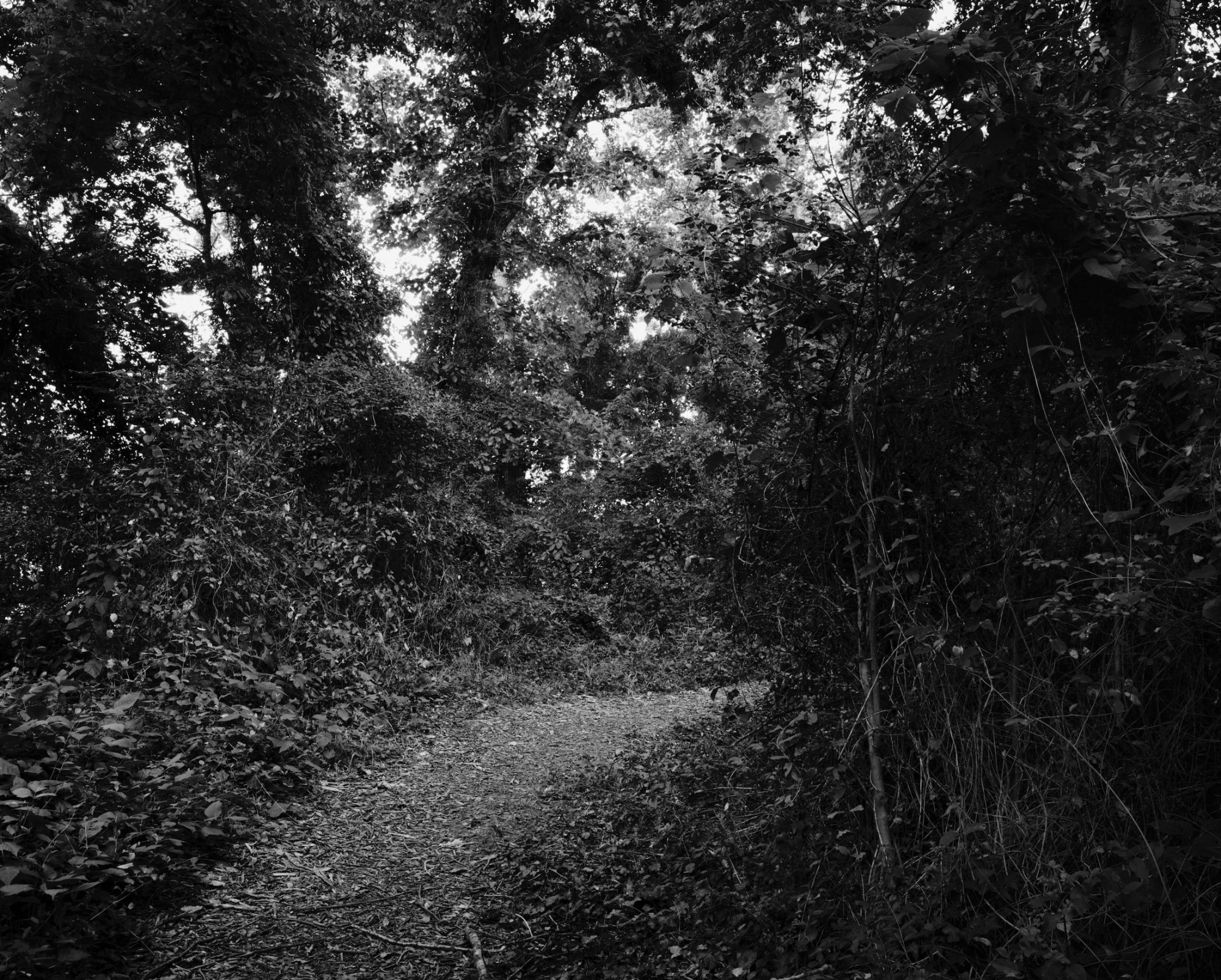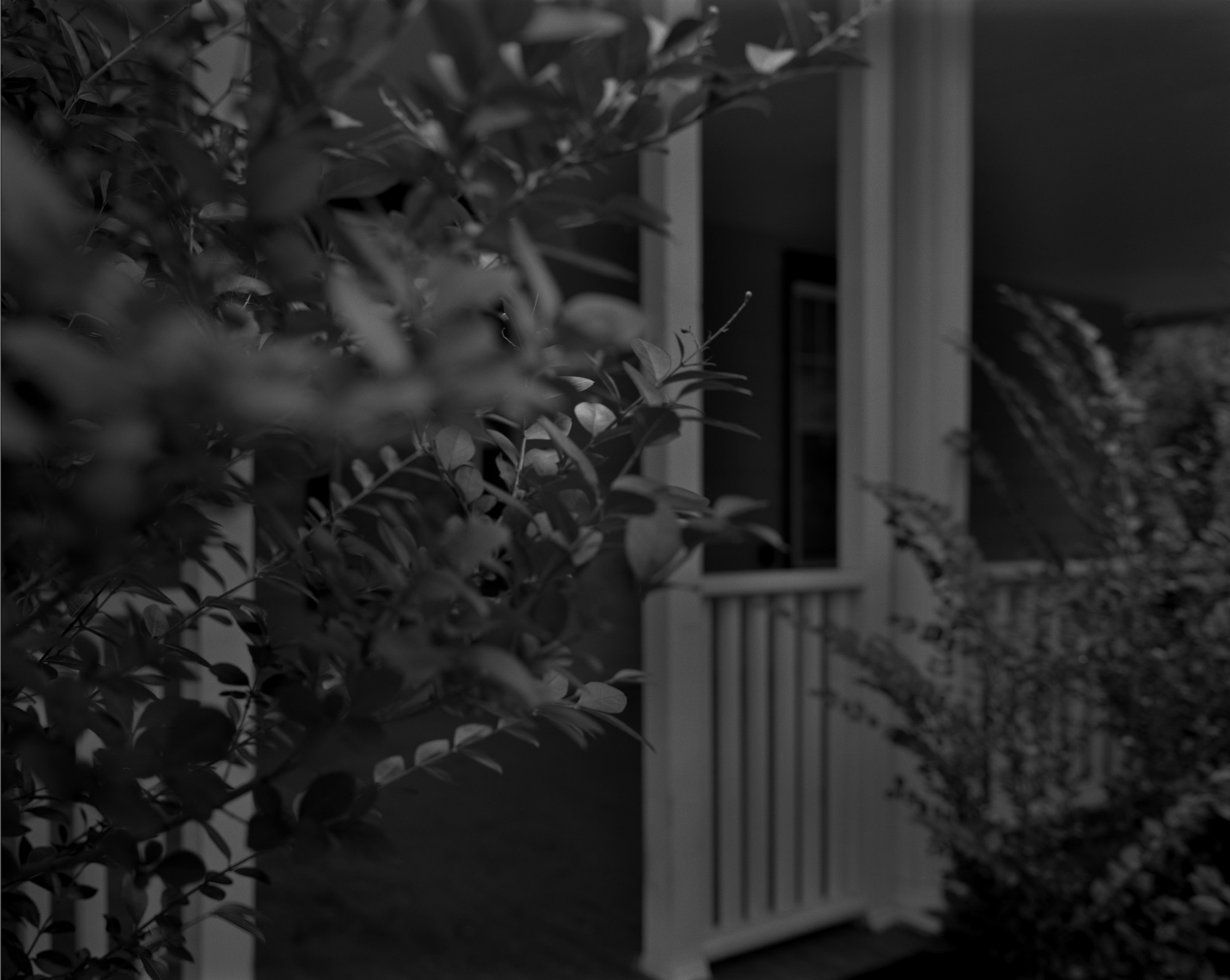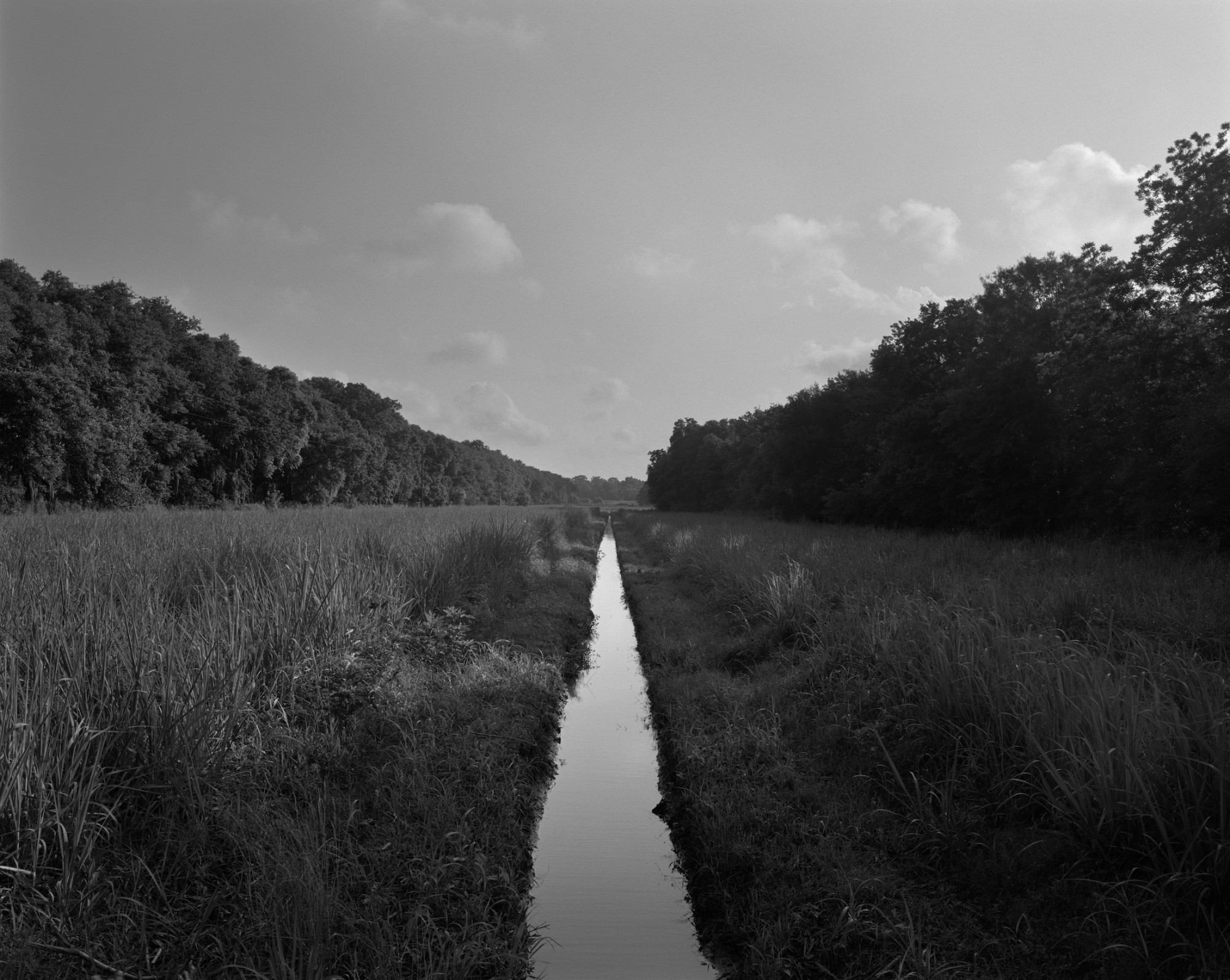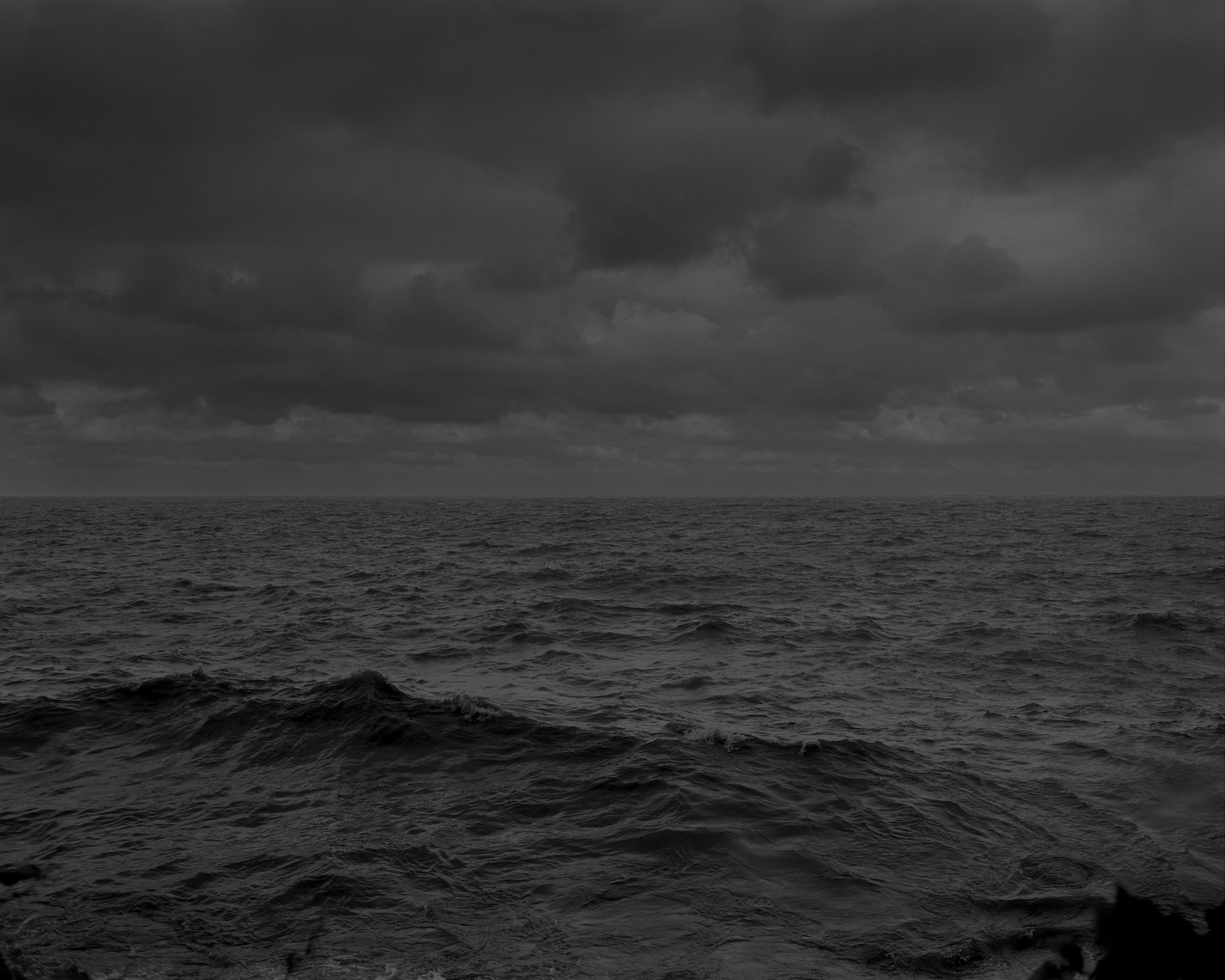
Cabin and Benches, a gelatin silver print from the series In This Here Place, 2019; All photographs © Dawoud Bey. Courtesy the Rennie Collection, Vancouver, unless otherwise noted. Bey’s work was on view through February 25 at the Virginia Museum of Fine Arts, Richmond. Elegy, a catalog of the exhibition, was co-published in December 2023 by the VMFA and Aperture
Elegy
Dawoud Bey makes the past visible in the present
By Danielle Amir Jackson
Dawoud Bey became well known for an approach to portrait photography that captured everyday people in their natural landscape: posing on sidewalks, in doorways, at barbershops; with a lover in a lush, manicured park, or a best friend in front of an ice cream parlor called Lady D’s. Sometimes his subjects were in motion, visibly navigating the physical and psychic distance between one location and the next. Bey’s style allowed his subjects’ radiance to shine through, for their stories and emotional depth to be reflected and refracted back to us through the artist’s own sensitive gaze. He was always attuned to history in ways both microscopic and grand. On uneventful days in Harlem of the late seventies; Brooklyn, Washington, D.C., and Syracuse of the eighties; or Birmingham on the fiftieth anniversary of the bombing of 16th Street Baptist, Bey created a gift for us: a chronicle of the past several decades of Black American striving, rendered in the kind of intimate detail that foregrounded softness, love, and wit.
For the past decade, the master portraitist has turned his gaze on landscapes, spaces that have often been supporting characters in his work. This late oeuvre, he tells us, “continues this idea of engaging the past through the conceptual lens of the present, [by looking] at the present-day American landscape and [making] its history resonant through a deeper look at the place of African Americans embedded in the history of those landscapes; to again make the past visible in the present.” In Elegy, on view at the Virginia Museum of Fine Arts this past winter, three different series of the artist’s landscape photographs—from Louisiana plantations, Virginia’s “slave trail,” and known sites of Ohio’s Underground Railroad—were brought together. They create, in concert, a lyrical meditation on the ways rivers, streams, fields of sugarcane, clapboard cabins, and hidden pathways through evergreen forests have shaped our identities as a people, as a nation. They document how we have, in turn, shaped this land. Over email, Bey discussed his practice, his own Southern heritage, and the literary works and music that have inspired his virtuosic image-making.

Untitled (Curve in the Trail), a gelatin silver print from the series Stony the Road, 2023. Courtesy the Virginia Museum of Fine Arts, Gift of Mrs. Alfred duPont, by exchange
Danielle Amir Jackson: What is the relationship between your portrait photography, which you made for so many years, and the landscapes in Elegy? How do bodies inform the landscape—the clearing in the woods near the James River, the bare trails, the trees, cabins? And vice versa: How do landscapes and setting inform your portraits?
Dawoud Bey: From the beginning, the Black subjects in my portrait-based work have been given meaning and context through the spaces and places that they occupied. We tend to read a person in a photograph both through their physical presence and through where they are situated. It is one of the ways in which the mute photographs give us a deeper sense of exactly who we are looking at. That can, of course, also be misleading, since people are more than their momentary geographic circumstances. But I’ve always used place as part of the narrative and context in my work, even going back to my first project Harlem, U.S.A. The people in those photographs resided in the Black community of Harlem, but just as importantly, Harlem is a part of the United States, so they are American subjects.
In my current work, there is an apparent absence of the human presence. But I am actually making those photographs from an eye-level vantage point that suggests how those landscapes might have been seen and experienced by the Black bodies moving through those spaces: whether in fugitivity through the darkened landscape of Northeastern Ohio as they moved towards Lake Erie and freedom in Canada; or on the plantations in Louisiana from which they sought their self-liberation; or [on] the Richmond Slave Trail (or the Trail of Enslaved Africans), having their first encounter with America and with slavery [as they moved] along that trail into captivity. [I’m] ever mindful of the Black presence and how that presence has marked and shaped the meaning of these landscapes, even when that Black human presence isn’t visible. That Black presence is embedded in the ground that makes up those landscapes, so they are never absent.
You have engaged with ideas and the history of the American South for a while in your practice, dating back at least to The Birmingham Project. Could you talk to us about your relationship to the region?
The South is the beginning of the Black presence in America by virtue of it being the dominant place of Black chattel slavery. So, the messy and horrific history of the American South is something that all Black Americans inherit whether they want to or not. It’s foundational to our collective history in this country and continues to inform the present. My mother’s side of the family is from West Point, Mississippi, so I am only one generation removed from the South.
I started to think about it as a place more deeply when I began reading Albert Murray’s South to a Very Old Place sometime in the mid-1970s. Murray’s telling of growing up in the region gave me a sense of both the complicated history between the races that [is] rooted in that part of the country, [and] a sense of the literary voice that the South gave rise to. From there I gravitated towards other Black writers like Ernest Gaines, whose writings, [including] A Gathering of Old Men, Of Love and Dust, and A Lesson Before Dying, were situated in the South. Murray was from Alabama and Gaines was from Louisiana. Something about their work attracted and resonated with me, maybe because it was so different from the urban life I was born into and echoed what I imagined my mother’s and other Southern-born relatives’ lives had been like.

Untitled #4 (Leaves and Porch), gelatin silver print from the series Night Coming Tenderly, Black, 2017

Irrigation Ditch, a gelatin silver print from the series In This Here Place, 2019
Throughout the discussion of your work are references to other texts, like The Sweet Flypaper of Life by Langston Hughes, Toni Morrison’s oeuvre, work by Lorraine Hansberry, Solomon Northup’s narrative, and more. How does literary art inform your practice?
I very much see the work that I am doing as being part of a larger history of Black expressive culture in all forms—visual, musical, and literary. I’m a former drummer, and music is central to my creative formation and thinking. John Coltrane was probably my first significant creative inspiration, particularly his album A Love Supreme, which to me was radical for Coltrane’s musical rigor and ambition as much as [it was] for being highly intentional. He spoke openly of wanting his music to be “a force for good.” This notion, that one could be rigorous and as groundbreaking, while also being clear about [how one] wanted his life and work to function in the world, became a very early inspiration to me.
As an artist working within the medium of photography, Roy DeCarava was a very early inspiration. My initial exposure to his work came through the book The Sweet Flypaper of Life, which was a collaboration between DeCarava and Langston Hughes. Once I began to experience DeCarava’s actual work in galleries and museums, I got a whole different sense of his singular brilliance and ambition. DeCarava made richly nuanced and interpretive prints, which were possessed of a compelling darkness that heightened both the drama and the material quality of description of his Black subjects. He made darkness and blackness a thing of material beauty. The blackness of the narrative, the blackness of the subjects, and the rich blackness of the prints [themselves are] what made his work so compelling to me.
Toni Morrison is also a deep inspiration and influence on my work. She both mines and reinvents the histories that Black subjects inhabit through her brilliant use of language and metaphor. I’ve made that conversation evident by referencing some of my Black cultural antecedents like Morrison and Hughes in the titling of my projects, such as Night Coming Tenderly, Black, which comes from the last couplet in Langston Hughes’s poem “Dream Variations,” and In This Here Place, which comes from a passage in Toni Morrison’s Beloved. The new work Stony the Road takes its title from a line in what is referred to as the Black National Anthem, “Lift Every Voice and Sing” [by James Weldon and J. Rosamond Johnson]. This all has to do with cultural continuities and wanting to make those connections [explicit] in my own work, to make clear to the viewer that the work doesn’t just spring from the imagination but is part of an intentional conversation with my own cultural history and my desire to bring that history forward.

Untitled #25 (Lake Erie and Sky), AP250,000, a gelatin silver print from the series Night Coming Tenderly, Black, 2017
Christina Sharpe calls the blacks in your black-and-white gelatin prints “velvety.” Why and how do you create so much depth and texture in these images?
A photograph is not merely a visual representation of a thing, it’s a material and physical object in and of itself. The prints for Night Coming Tenderly, Black are a kind of virtuoso performance; they are certainly the most difficult prints I’ve ever made. And they are very much inspired by the rich, dark prints of Roy DeCarava. They were printed specifically to realize the idea of how the landscape might have appeared to those making their escape from slavery under cover of darkness.
They’re not meant to be any kind of documentation; they’re a subjective idea visualized. I still photograph on film, and that film can be interpreted and printed any number of ways. I use scale to bring a physical and material sense of the world in which I make my work into the museum or gallery space, to move the photographs from being an object-based experience to something more experiential and engulfing, something that gives the viewer room to feel like they can enter into the work and move around in it. For this history-based work it’s also important that the work is made in black and white, since that is the material of photography’s history. If this work were in color, it would look and feel very different; it would scream “now” more than “then.”
Finally, since I’m using film, it’s important that I’m making this work with a medium-format tripod-mounted camera. The large negative holds more material information and yields a print with more information. And the camera being mounted on a tripod allows for minimum amount of shake and movement during the exposure
What can you share with us about what you are working on now?
I’m presently in the research and location-scouting phase for [my next work of] film. It will be based on my own personal history, an incident that occurred when I was ten years old in 1963, the same year as the dynamiting of 16th Street Baptist Church. I’ve also been researching and compiling a list of other sites and landscapes where significant history took place. Eventually I’ll make some decisions about which sites to start visiting. The last two years were taken up in making the photographs and the film work for the current exhibition, and I always have to do a lot of research before I actually begin working, so that I’m as deeply steeped in the histories of the places as I can be. I never just show up and start working. I need to really know where I am in order to work with the kind of integrity I want. There’s a lot of work still to be done.
Celebrated for his rich, psychologically compelling portraits, Dawoud Bey was born in Queens, New York, in 1953. Highly regarded as an educator as well as a photographer, Bey’s work has been defined by the empathy he brings to his subjects and the complexity with which he depicts them. Renowned for his early street photography and deeply probing portraits, the artist’s recent bodies of work focus on the construction of history and memory. Bey holds a Master of Fine Arts from Yale School of Art and is Professor of Art and former Distinguished College Artist at Columbia College Chicago. He has received a MacArthur Foundation “Genius” Fellowship, the Guggenheim Fellowship, and fellowships from United States Artists and the National Endowment for the Arts. Bey’s works are in several international permanent collections, including the High Museum of Art, the Museum of Modern Art in New York, the Solomon R. Guggenheim Museum, the Studio Museum in Harlem, the Tate Modern, and the Whitney Museum of American Art.



